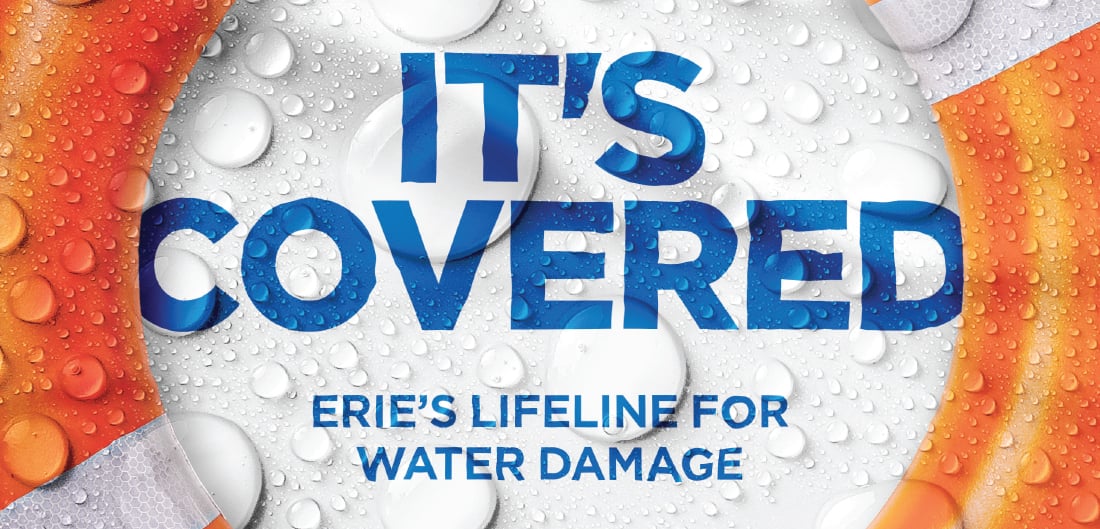Flooding is the most expensive and frequent natural disaster in the United States.
It’s not covered by home insurance.
When you buy a homeowners policy, you’re paying for the peace of mind that your home and belongings are protected. Yet, all too often, policyholders learn the hard way that, even though they feel like they have coverage in place for every possible scenario, a typical home insurance policy provides no protection at all when it comes to flooding.
“We’re talking about a true blind spot in the industry,” says Michelle Tennant, who oversees ERIE’s home insurance products. “Private insurers have for the most part, looked the other way when it comes to floods.”
Because of the potentially devastating costs of flooding and the nearly universal practice of excluding flood claims from homeowners policies, Congress created the National Flood Insurance Program (NFIP) in 1968 to help fill the gap. While home buyers in designated flood zones are familiar with the program—banks typically require a policy to be in place before they’ll approve a mortgage—homeowners who live outside of these areas may have never even thought about flood coverage.
It's an oversight that can prove costly, experts warn.
“A lot of people think that, since they’re not in a flood area, they must not be vulnerable to flooding, and that’s simply not the case,” says Benjamin Collier, Ph.D., an ERIE Customer and insurance economist at Temple University’s Fox School of Business and research fellow at the Wharton School at the University of Pennsylvania, whose research analyzes the NFIP.
Whether your mortgage requires coverage or not, floods can happen anywhere; and just one inch of water can cause $25,000 or more in home and property damage.[1] While even a relatively small incident might cost you a pretty penny, it could pale in comparison to the devastation of facing a total home loss with no insurance coverage at all.
“It just isn’t acceptable,” says Doug Smith, ERIE’s executive vice president of sales and products. “Our founding purpose includes providing our policyholders with as near perfect protection. If we’re following the industry’s lead in letting Customers fend for themselves when it comes to this significant risk, then we simply wouldn’t be living up to that.”
That’s why, after years of navigating the complex legal and regulatory frameworks common to the insurance industry, Erie Insurance recently delivered on the longstanding goal of giving Customers the option to add flood and sewer and drain protection in one package to their ERIE homeowners policy.
The result is Extended Water Coverage.
Of course, if all ERIE did was meet a need already addressed by the NFIP, it would hardly be worth doing in the first place. That’s why Extended Water goes far beyond what the federal program has to offer.
“We’ve taken coverage that was historically available through a government program and are delivering it directly, backed by ERIE’s promise of service and the expert advice of an ERIE Agent,” says Smith.
Tennant, who leads the various ERIE teams responsible for pricing, administering and servicing Extended Water, agrees.
“It takes a lot of people working really hard to pull something like this together,” she says. “I’m proud that ERIE is taking the lead in giving Customers a genuinely superior way to meet this need.”
Do You Live in a Flood Zone?
Whether you are among the 13 million Americans who live in a formally designated flood zone—an area with a 1% annual chance of flooding, according to the NFIP—anyplace it can rain, it can flood.
“It seems like those maps have underestimated the likelihood of flooding as new information about how to model flooding has developed,” Collier says. “Even outside of those flood zones, there’s much more likely than a 1% chance of flooding.”
Indeed, 98% of counties in the United States have experienced flooding to one degree or another in the last five years alone. That includes ERIE’s footprint.
“Every community where ERIE does business is susceptible to flooding to one degree or another,” Smith says. “Extended Water lets us protect our customers from a potentially life-altering property loss with coverage endorsed right onto their homeowners policy.”
Extended Water Is More Than a Flood Policy.[2]
The thought of a flood brings to mind images of big storms and homes engulfed by rising waters. But even something as minor as poor neighborhood drain design—Extended Water includes Sewer or Drain Backup Coverage—or a sudden rush of melting snow can lead to costly damage that isn’t covered by most home insurance policies.
Besides providing invaluable protection against watery intrusions large and small, Extended Water coverage can be there for you before and after the storm (or snow, or broken water main).
And with Flood Avoidance Reimbursement[3] included, we’ll reimburse you for efforts to prevent flood damage before it occurs, up to $10,000. If you end up displaced by flooding, you'll be covered for additional living costs associated with temporarily relocating while your home is being restored.[4]
It’s about more than just protecting your home and belongings. It’s about seeing you through, from beginning to end.
Get Started Today
Your ERIE Agent is ready to speak with you about Extended Water, including how it works and what it costs. Reach out today to protect your home and your belongings with coverage other carriers simply can’t match.
